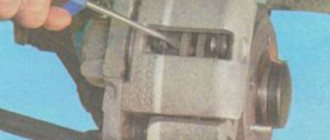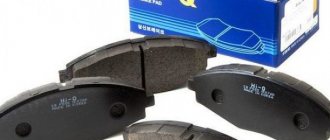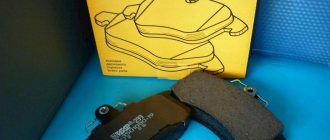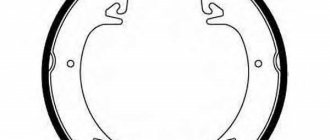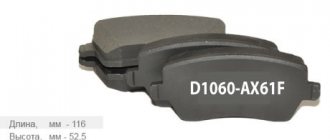Many car owners, when purchasing the next set of spare parts for maintenance, do not even suspect that replacing brake discs is the same mandatory procedure as installing new pads. Sometimes it comes to the point that the next time you press the pedal, an important element of the brake system simply falls apart and the car, control over which is lost at that moment, gets into a serious accident.
- Replacement of VAZ brake discs. Video:
- When to change brake discs? Video:
- Useful tips
How to avoid such situations and breakdowns associated with failure or damage to critical parts? Let’s clarify this issue by covering the problem in as much detail as possible, and give some useful recommendations.
There is a similar article on this topic - Grooving brake discs with your own hands.
Limit resource
With each contact with the pad, the disc wears out, although its thickness does not decrease as rapidly as the thickness of the friction linings. And yet there comes a time when wear exceeds acceptable limits. The minimum permissible thickness of the brake disc must be indicated by the manufacturer in the technical specifications of the car.
Even for one model, it may vary depending on the modification. For some cars, the resource is enough for 100 thousand km or more.
For others, replacement time occurs after several tens of thousands of kilometers. Most car manufacturers stipulate replacement times for important components. But these are approximate figures, since many factors influence the rate and nature of wear.
Influencing factors
The choice of pads used for replacement during maintenance has a serious influence. Most manufacturers have their own recipe according to which friction linings are made. The physical characteristics of these pads may vary.
It is optimal to purchase discs and pads from the same manufacturer. Their parameters are selected in such a way as to ensure optimal braking while maintaining the overall resource of the node.
Much depends on the operating conditions of the equipment and the driver’s driving style. Affects the wear and condition of the entire system as a whole. Malfunctions that arise sometimes significantly reduce the service life of parts. The necessary recommendations are required to be given by employees of dealership centers. But you should not completely rely on their integrity.
To know when to replace brake discs, it is recommended to regularly inspect them and measure their thickness. Before starting measurements, it is necessary to clarify the vehicle configuration option. ventilated brake discs and conventional ones can be installed on the same car They differ in size.
Important! Measurements should be taken not along the edge, where a side often forms due to wear-out, but along the plane of the disk.
The wear of the surface on which the pads press is uneven. This is due both to the structure of the friction linings themselves and to the entry of foreign objects such as small stones into the gap between the pad and the disc. To prevent this from happening, foreign objects must be removed in a timely manner. If the issue is in the structure of the friction linings, you should refuse to use parts from a less than conscientious manufacturer.
Dangerous overheating
Car owners often wonder why the brake discs on their car get hot . In fact, periodic increases in temperature are normal.
The more intense the braking, the higher the heating. But if the temperature remains high even after prolonged movement with the pedal released, this means that the calipers do not release the brakes due to souring of their pistons or guides.
In this case, the wear of parts accelerates sharply. The fault must be corrected immediately. Sometimes it is enough to clean the parts from dirt and rust. But repairs and even complete replacement of the unit may be required.
Let's get to work!
- Hang the axle you are going to work with in any available way.
- Secure the car - place stands under the flanges of the sills, stop any wheel standing on the ground (or better yet, both) with “shoes” or suitable stones, in a word - make sure that the car does not roll under any circumstances. It is allowed to hang the wheels one at a time, but according to safety regulations, you should not work with a car that is only standing on a jack; additional and more reliable support is needed
- Remove the wheels
- Assess the condition of the brake system parts. If you have to buy something additional for repairs (for example, a brake hose), then it is better to discover it at this stage, and not when everything has already been disassembled and you won’t be able to drive the car for spare parts.
- Unscrew the caliper from the bracket, and the bracket from the steering knuckle or axle. In some models you don’t have to remove the bracket, in others you can only remove the caliper, in others you need to disassemble the entire structure to insert a new disc. Check the condition of the guide pins again - the caliper should “ride” along them smoothly, without excessive play or jamming, the boots should be intact, and no lubricant should leak from under them. The caliper piston seals should also not have cracks, leaks or other damage. Do not rush to remove the old brake pads from the caliper; you will need them later.
- Remove the old brake discs by unscrewing the wheel guides or using an impact screwdriver to unscrew the screws securing the disc to the hub. Pay special attention to the design of the rear disc brakes - often before removing the rear discs, you need to bring together the handbrake pads located inside the disc.
- Remove the new brake discs from the packaging. Before installation they must be cleaned of preservative grease and degreased; for this we recommend using an aerosol brake cleaner that does not contain acetone and chlorine derivatives, for example, from ASTROhim. This aerosol has a pleasant smell and is approved for use indoors. Place the disc over the waste fluid container and point a powerful spray of a spray can onto the surface of the parts on both sides from a distance of 3-5 cm until the conservation lubricant is completely removed.
- To avoid the brake disc sticking to the hub, it can be lubricated with copper, graphite or lithium grease.
- Fully extend the pistons of the brake cylinders: they must be recessed flush with the caliper body, because the new disc does not have a groove that would “forgive” the reduced installation gap. Even when using a special threaded or hydraulic device, rest it against the old brake pads - this way there will be a larger area of pressure, and therefore less chance of damaging the fragile piston or its boot. If the pistons have the already mentioned threaded finishing mechanism, to completely recess them into the cylinder, use a special tool and tighten them.
- Install new brake pads into the caliper and reassemble the mechanism in the reverse order.
- Before you start driving, ALWAYS press the brake pedal all the way down several times - this is necessary to press the pads against the disc - and check the fluid level in the reservoir.
- For the first 250-300 kilometers, avoid intense and sudden braking - the pads and discs should gradually get used to each other.
Affiliate Material
Possible options
The design features of the braking system depend on the intentions of the developers and the results obtained after preliminary calculations and tests. This affects the design of individual parts, their dimensions and material of manufacture. To increase braking efficiency, a vehicle can be equipped with:
- Vacuum boosters that increase the pressure in the hydraulic drive of the system. If they are available, a multi-ton machine can be stopped by lightly pressing the pedal.
- High efficiency calipers providing high clamping force on the pads.
- Perforated brake discs. Thanks to the presence of holes or slots on the working surface, the part itself becomes lighter and the coefficient of friction between the friction linings and the disk increases significantly. At the same time, pad wear accelerates. For this reason, this solution is resorted to if other ways to increase the efficiency of the brakes have been exhausted.
- Carbon wheels. The wide distribution of parts made of carbon with undoubted advantages is hampered by the high price of this material. Such components can currently only be found on very expensive cars.
Important! If you have a desire to make independent changes to the design of the brake system, remember that this can only be done after agreement with the equipment developer. Otherwise, the converted car can only be used on sports tracks.
If technical control authorities identify the fact of operating a car with modified brakes on public roads, according to the current legislation, the violator will not even face a fine, but a real prison sentence.
Car owners who repair the brake system of their car themselves or are simply interested in the design and maintenance rules of the equipment are often interested in the procedure for performing certain works. Let's talk about this too.
Removing the brake caliper.
The first step when replacing brake rotors is to remove the brake caliper. It is removed in the same way as when repairing brake pads . After unscrewing the screws from the caliper, place it on a cord or bracket. There is no need to unscrew the bolt on the brake system pipe.
Replacing front brake discs
To successfully complete the job, it is recommended to use a lift or jack in combination with reliable stops. Of course, depending on the specific car model, there are certain nuances. But the general sequence of actions on most modern machines is as follows:
- Loosen the wheel bolts.
- Raise the car until the tire stops touching the supporting surface.
- Unscrew the bolts completely and remove the wheel.
- We unscrew the caliper cover or (depending on the design) knock out the guides. After this, remove the brake pads.
- Since new pads must be installed along with the new disc, use a flat pry bar to completely recess the caliper pistons. At the same time, we make sure that they move freely and the anthers are intact.
- We unscrew the caliper from the mounting points. To do this, you may have to turn the steering wheel in one direction or another to ensure easy access to the bolts. We remove the caliper and use a wire to hang the suspension arm or car body on the shock absorber strut so that the hoses are free. Sometimes this requires first loosening or removing the clamps holding the hoses in place.
- Unscrew the screw (or screws) securing the disc to the wheel hub. After this we remove the part. It happens that it sticks to the seat on the hub. Then you will have to use a liquid wrench, a hammer and a soft metal drift.
- We clean the seat on the hub from dirt and rust and install the new part in place by tightening the fixing screw(s).
- Degrease the working surface of the disk.
- We fix the caliper in place.
- We install the pads.
- We put the wheel in place.
In fact, there is nothing particularly difficult here. The main thing is to have a good tool and the necessary consumables available. And, of course, hands growing from the right place.
For your information! Parts are changed only in pairs. It is unacceptable to carry out work on only one side of the machine.
When to change brake discs? Video:
What will you need?
Take your time to disassemble the car. First we need components and tools.
First, we will need new brake discs and pads. New! This is a very important circumstance. Do not install slightly worn or still normal ones, install new ones. Remember forever that when dealing with brakes, you should focus only on safety, and you should not try to save money or somehow show your ingenuity.
For example, some car owners, in an attempt to minimize financial losses from replacing discs, put their old pads on them. This is only a visible saving, since this causes the disks to deteriorate faster and become unusable. As a result, you will have to spend a lot more money.
Secondly, as you understand, we cannot reach the brake system with our bare hands, so we will need tools to replace it. You can also see how to use them in the video. The set is quite standard and does not include any specialized devices:
- set of wrenches;
- jack;
- stops (to immobilize the car).
It is preferable to have someone help you when removing the old brake system and installing the new one. You can also do it alone, but it will be much easier.
Replacing rear brake discs
The nature and order of operations, as a rule, does not differ from work performed on the front wheels. But sometimes you have to get to the mounting points for the calipers from under the car. If you have a lift, this is not a problem. If you only have a jack, you will need an inspection hole.
Although extremely rare, there are car models in which the discs are made integral with the hub. In this case, you will have to replace the entire assembly.
Carefully! After finishing the work, you need to press the pedal several times so that the pads fall into place.
It should be taken into account that at the initial stage, until the pads break in, the braking efficiency will be slightly lower than usual. Some manufacturers of spare parts supply lapping paste with the parts, which should be applied in accordance with the instructions for its use.
What affects wear?
There are no clear parameters on the issue of wear. Each manufacturer provides its own characteristics and digital parameters regarding this. There are tables for different makes and models of cars, as well as numerical data for each model within the same brand. Various indicators are related to engine power, the weight of the car, as well as the consequences of all the physical forces acting on the car during braking.
Which brake discs are better?
Of course, there are well-known brands whose product quality has been proven by experience. Among them we can mention Brembo, ATE, TRW. But on the one hand, new players are constantly appearing on the market, supplying products of fairly high quality, and on the other hand, you can find a fair amount of counterfeit parts on sale.
Replacement of rear and front brake pads. - there is more useful information here.
For these reasons, it is not worth trying to make a rating of brake discs , and when choosing spare parts, it is recommended to pay attention not only to the big name of the manufacturer, but also to the overall quality of the product.
Since you won’t be able to analyze the composition of the material from which the part you need is made at home, you should concentrate on the following parameters:
You will be interested in this article - Grooving brake discs with your own hands.
- Exact compliance with dimensions, due to violation of which assembly of the unit may be impossible. Poor balancing of the disc will cause it to run out, the extreme manifestation of which is the pulsation of the brake pedal when pressed. Such components will have to be immediately scrapped.
- Processing quality. It is unacceptable if the parts have burrs, burrs or deep scratches. Conscientious manufacturers do not allow this.
- Compliance with catalog numbers. They must exactly match those specified in the technical documentation or on the website of the company that manufactured the part.
As mentioned above, it is highly advisable to purchase discs and pads from the same manufacturer. In this case, the overall performance of the braking system will be higher, and the components will last longer.
Friction linings that are too soft, working in tandem with a disk made of hard alloy, will quickly wear out. Hard pads, on the contrary, will render a part made of soft metal unusable in a short time.
The best disc manufacturers
When replacing, it is important to choose a reliable option; you should not use products from other models or skimp on quality. All disks can be divided into three types: inexpensive, medium and premium segment. It is best to select based on the characteristics of the car; the more powerful its engine, the higher the requirements for the brakes.
Inexpensive options
A low price does not mean the same quality, it’s just that manufacturers are focused on the used car market or on cheap models that use the simplest, small-sized wheels. The following brands performed best:
- Avantech. A South Korean manufacturer that supplies products to the assembly lines of some automakers. An alloy of cast iron and carbon provides special strength, and a special coating protects against corrosion. This option is an order of magnitude cheaper than most analogues with comparable quality.
- Nipparts. The Dutch company produces brake discs for Asian cars and sells them throughout Europe. They are distinguished by good quality, high safety standards, and low prices. During production, they are tested for braking efficiency for the best performance.
- Bosch. The brand is German, but all factories are located in Asia, and the quality meets all standards; the products are supplied to many automobile conveyors. The discs are cheap, but this option is only suitable for those who use the car in standard mode; if you often have to brake urgently or drive in the mountains, it is better to choose another manufacturer; under high loads, the efficiency is greatly reduced.
- NIBK. The Japanese company began producing parts for brake systems only at the end of the last century, but its quality and reliability made it popular all over the world. A wide range allows you to find discs and pads for most models, prices are at an average level.
- Ferodo. British concern producing brake discs. They are manufactured using a special nonlinear processing technology, which ensures quality and long service life.
For your information! Some automakers recommend certain manufacturers of spare parts. It is better to follow their recommendations as all the brands offered are tested and ensure safety and reliability.
It is worth buying discs from trustworthy stores. There are a lot of fakes on sale, which are much cheaper, but the quality is so low that the service life is reduced significantly. Contact an official representative of the brand, if there is one.
Medium and expensive price segment
They are used as a replacement for original products, which most often cost much more. Middle-class products are of good quality; all the brands presented have been in business for a long time and their production process is streamlined. Best options:
- Blue Print. British company with factories in Asia. Made from steel, the surface is perforated in a special way to ensure better adhesion to the pads and minimal braking distance.
- Masuma. The Japanese brand, which has the lowest number of manufacturing defects of all the companies represented, products are purchased by some Asian car manufacturers. There are often fakes on sale.
- Schneider. A German company focused on vehicles used in extreme conditions and heavy loads. Produces ventilated, cross-drilled discs that provide very effective braking in difficult conditions. But the pads will wear out much faster.
- Lucas (TRW). German manufacturer of brake system parts. The products are painted black, which protects them from corrosion and makes them recognizable. The price is low, but some models have a short service life, especially with aggressive driving.
- Brembo. An Italian company that produces high-quality wheels using special technology, which provides a warranty period of up to 80,000 kilometers. The model range is constantly updated, there are many options, so you can choose them for almost any model.
This group is distinguished by good quality, it is suitable for everyday driving, and there are options for those who use the car under high loads. It is worth selecting based on engine power and the nature of operation; sometimes it makes sense to install larger discs to increase braking efficiency.
As for expensive options, the quality is always high, but each has its own characteristics:
- Fremax. Suitable for extreme driving, packaged without air access, so there is no need to degrease the surface.
- DBA. They have perforations, which ensures good braking even when water gets in, are resistant to overheating, and have a long service life.
- AND THOSE. It supplies products to many manufacturers, there is a line for extreme driving, it can withstand high temperatures without breaking the geometry.
- Otto Zimmermann. They produce wheels for the VAG concern and other European manufacturers. The quality is high, it has good wear resistance.
- EBC. Expensive products for sports cars and premium cars. Defect rates are minimal, performance characteristics are among the best.
You should not buy expensive options for a small car, since there will be almost no difference compared to cheap models due to low loads. When choosing, you can read reviews, since different brands have their own optimal price solutions.
Replacement tool
You will need several tools for the job. This is a standard set of keys and sockets, a jack, and a wheel wrench. A hole or overpass, a tripod for fixing the car, wheel chocks, and also wire will not be superfluous.
It is best if this operation is performed with an assistant. This will significantly speed up the process of replacing the rear disc in a garage. Before you begin dismantling, you should find out whether self-locking bolts will be needed, or if you can get by with regular ones.
Vehicle operation
This is a factor that largely depends on the driver. For example, in winter, while using the car, it is very easy to deform the rear brake disc. As it moves, it heats up, and since it is quite cold outside, serious temperature changes cause the metal to deform. If this happens often enough, repair or replacement is inevitable.
Restore or change?
When it is possible to determine the degree of wear (or if you notice that the brake pedal jerks when braking), the car owner is faced with the following question: replace the damaged part or try to restore it? Many are trying to implement the second option. It must be remembered that the disc can be sharpened, but only if the residual thickness is four or more millimeters.
Service center specialists recommend changing the rear brake discs (Ford is no exception). However, if the prices for a new part seem too high, you can try to do the repair yourself.
It is important not to forget that the greater the layer of metal that is removed during the repair, the shorter the service life of the part being described. Also, experts do not recommend installing contract disks. In this case, you will not have accurate information about where they were installed, how they were operated, and the like. They may also have to be repaired soon.


